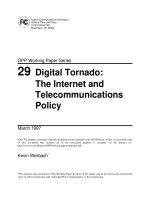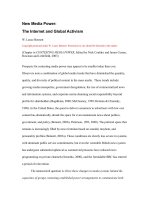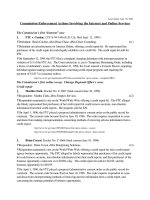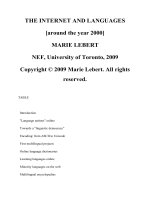infomation technology the internet and you binary
Bạn đang xem bản rút gọn của tài liệu. Xem và tải ngay bản đầy đủ của tài liệu tại đây (104.95 KB, 10 trang )
TOPICS
• Information Representation
• Characters and Images
• Fundamentals of Digital Computer Design
Information Representation
• All information must be rendered into binary in order to be stored on a computer.
• Besides numbers, almost all applications must store characters and string information.
• Images are pervasive in today’s internet world and must be rendered in binary to be
handled by internet browsers.
Character Representation
• ASCII – PC workstations
• EBCDIC – IBM Mainframes
• Unicode – International Character sets
ASCII
• ASCII
• Expanded name
American Standard Code for Information Interchange
• Area covered
7-bit coded character set for information interchange
• Characteristics/description
Specifies coding of space and a set of 94 characters (letters, digits and punctuation or mathematical symbols) suitable for the interchange of basic English language
documents. Forms the basis for most computer code sets
ASCII
EBCDIC
• EBCDIC
• Expanded name
Extended Binary Coded Decimal Interchange Code
• Proprietary specification developed by IBM
• Characteristics/description
A set of national character sets for interchange of
documents between IBM mainframes. Most
EBCDIC character sets do not contain all of the
characters defined in the ASCII code
EBCDIC
• EBCDIC
• Usage
Not much used outside of IBM and similar
mainframe environments. When transmitting
EBCDIC files between systems care needs to be
taken to ensure that the systems are set up for the
relevant national code set.
EBCDIC
UNICODE
Unicode can represent all of the world's characters in modern computer use, including
technical symbols and special characters used in publishing. Because each Unicode
code value is 16 bits wide, it is possible to have separate values for up to 65,536
characters. Unicode-enabled functions are often referred to as "wide-character"
functions.
UNICODE
Note that the implementation of Unicode in 16-bit values is referred to
as UTF-16. For compatibility with 8- and 7-bit environments, UTF-8
and UTF-7 are two transformations of 16-bit Unicode values. For
more information, see The Unicode Standard, Version 2.0.









